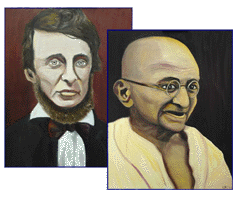"The whole aim of practical politics is to keep the populace alarmed (and hence clamorous to be led to safety) by menacing it with an endless series of hobgoblins, all of them imaginary." ~ H.L. Mencken
The Clothes Make the G-Man
Column by new Root Striker antiox.
Exclusive to STR
Who knew that Janet Napolitano was a fashionista? What other conclusion can we come to after finding out that in addition to the war on Islamic fascism, her department is now waging another in favor of idiotic faddism? That’s right, the Department of Homeland Security has taken to setting up surreptitiously in local flea markets and then springing into SWAT mode once the evidence of knock-offs on the premises has accumulated. The humiliating spectacle of peasants on city streets with handbags nearly identical to those on the shoulders of 1 percenters will no longer have to be endured. And finally the DHS can be taken seriously. National pride will be renewed in a world where, we can rest assured, products labeled Gucci, Louis Vuitton, Nike, North Face, True Religion and Tiffany are the real thing.
Why haute couture is the province of a bureaucracy that was invented to prevent another 9-11 is probably something that, like high style, most people will just never “get.” Until now I’ve not given a moment’s consideration to the pedigree of my Levi’s. An enormous government agency that is armed to the teeth and concerns itself with such things tends to take up a lot more of my attention. A recent raid at Baltimore’s Patapso Flea Market that was reported 4-23-12 in The Baltimore Sun alerted many of us to the DHS role in policing fashion.
That investigation took two and a half years and involved renting a booth in the space. Anyone that is familiar with both flea market prices and what government spends on investigations might have trouble doing the math here. Caveat emptor is a concept willing purchasers may employ, while the federal government arrogated the right to be fools with taxpayer money a century ago. People that refuse to accept this risk ending up like Gordon Kahl.
The rationale for the program was contained in a statement made by William Ross, unit chief of the National Intellectual Property Rights Coordination Center, a major division of DHS, at the National Press Club on June 23, 2011:
“The protection of intellectual property is a top priority for Homeland Security Investigations, as counterfeit products represent a triple threat by delivering shoddy, often dangerous goods into commerce, by funding organized criminal activities and by denying Americans good paying jobs.”
So, if you were wondering what is going on here, “it’s the economy, stupid.” US Customs reportedly seized $261 million in counterfeit goods in 2009, which is probably less than what is nationally spent on coffee per day. Ross spoke at the NPC on a panel with representatives from Pfizer, Eaton and Global Marketing. It was noted there that in Fiscal Year 2010 HSI, US Customs and Border Protection combined seized $1.4 billion worth of goods at the “manufacturer’s suggested retail price.” Anybody that has heard of Marshall’s, T.J Maxx, outlet centers or clearance sales can cut that figure anywhere from 50 to 75%. DHS, meanwhile, sucks down about $100 billion that we know of per annum. What we shell out getting saved from a “phony” sports jersey is not likely to compute into a good deal, for taxpayers at least.
That anyone willing to pay the better part of a C-note for a glorified T-shirt with someone else’s name on it is capable of owning “intellectual” property in the first place is a good one. G-men can be funny, and some day it may even happen intentionally. What is less amusing is that they also believe that undercutting marketers of such schlock helps prevent denying “Americans good paying jobs.” A future in shirt factory work for Joe-Six Pack is something a Fed is willing to fight to protect, especially if he can get a badge, full medical, retirement, paid vacation and numerous other benefits doing it. They’ll use guns, tasers, cameras, cuffs, shackles, lawyers, courts and penitentiaries, keeping the sweatshops they approve of in the black.
Back in July of 2010, Dana Priest and William M. Arkin of The Washington Post did a series of articles on the vastness and vagaries of the Department of Homeland Security. It reported on a colossal structure with 854,000 employees and private contractors. Many of them are living in gated communities isolated from the population they supposedly protect. Most of their work is done in heavily guarded fortress like compounds where technocrats and “operatives” enjoy complete oblivion to the plebian world. The authors quoted then director of national intelligence Admiral Dennis C. Blair responding to criticism:
“Much of what appears to be redundancy is, in fact, providing tailored intelligence for many different customers.”
The admiral never explained what he meant by “customers,” but the word “tailored” is an interesting choice in context. Any casual observer can see that people in the DHS racket neither skimp on their wardrobes nor tend to consort with people who do, except, perhaps, when busting them as posers. As far as “what appears to be redundancy” is concerned, weeks later the admiral added:
“After 9-11, when we decided to attack violent extremism, we did it as we so often do in this country, the attitude was, if it’s worth doing, it’s probably worth overdoing.”
But the question here is “overdoing” what? It seems to me that dispatching heavily armed spooks into the retail sector for years is violent and extreme. Our nation faced a gradually expanding threat of international intrigue, sabotage, wanton massacre and vilification that finally stunned the world 21 months into a new millennium. It was literally the kind of mission that James Bond was sent on with a license to kill in Ian Fleming’s overblown novels. Now Daniel Craig might break bad at an outlet center somewhere in a scene littered with pumps, lingerie, pants suits and little black dresses. The critics could have no legitimate qualms with the flick’s realism.
J. Edgar Hoover was famously fastidious about dress if not obsessed with it. He wasn’t motivated by sheer vanity. G-men were expected to be physically, academically and morally superior to the general herd. This was no different than liege lords of antiquity that demanded finery in their knights’ attire. The commonality was put into its place by the splendor of the noble entourage. A paramilitary caste with a certain amount of contempt for the masses was deemed a healthy one. Nietzsche refers to this in his essay, “The Lack of Noble Manners “ (or “Presence”in some translations). As European society matured, knightly missions and rulers’ raiment (see Don Quixote, The Emperor’s New Clothes), became the stuff of comic legend.
What could account for policy so ludicrous it would never occur to the creators of “The Keystone Kops,” “Car 54 Where are You?,” “Get Smart” and “SledgeHammer” even if they pooled efforts? The answer isn’t really hard to come by. The fact is that the human race is rife with people who want to believe they are the indispensable ones born to quell an inevitable threat somewhere. These indispensable beings are noble and few but world perils are infinite. Once the government hoses them down, badges ‘em up and provides the ordnance, they are going to find bad guys out there. Mad bombers might be more delectable but scofflaws will supplement in a poor harvest. The best we can do is try like hell not to look too guilty. A steady supply of new laws and regulation provides villainous fresh meat for the saviors of our feeble race.
Secretly they can’t help but question a polity where self-interested slobs like you and I have just as many votes, rights and slick sets of threads as they do. We can only wonder how great the disparity has to become before they notice we don’t.
(1 vote)








 Reprint Rights
Reprint Rights